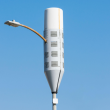The advantages of close spacing
A version of this article appeared in the November 2012 print issue with the headline: Get cozy.
With an eye toward spectrum efficiency, this article will examine methods for working with regional planning committees, frequency coordinators and the FCC in order to effectively manage capital and operating expenditures related to land mobile radio site deployments. Advanced techniques for managing co-channel and adjacent channel interference will be addressed, as will tactics for overcoming the inefficiencies of the Carey/R6602 curves. Issues with close-spaced spectrum and sites also will be examined.
Continuing with the theme of resource management that has been the foundation for this series, an opportunity exists when working with the FCC to locate base-station sites. That opportunity is to leverage advanced radio frequency engineering techniques in order to optimize close spacing, which may help to reduce the number of sites when overlapping radio coverage is not needed. The first step is to understand traditional engineering methods, such as:
-
Height Above Average Terrain (HAAT), a method for analyzing transmitted power and antenna location.
-
Carey, or R-6602, curves, which are used to calculate signal strengths to determine service and interference zones.
-
Line-of-sight (LOS) calculations, which are used to determine coverage to the horizon.
Understanding how the FCC requires licenses to be completed will allow for site locations to be as close as possible. The Carey Curve method represents a broad view, and by using more advanced techniques it is possible to work with the FCC on a case-by-case basis to help eliminate unnecessary sites stemming from antiquated technologies or outdated rules.
In 1964, Roger B. Carey published a paper that became the standard by which land mobile radio engineers, and the FCC, predicted the normal range of VHF and UHF radio signals and how much co-channel interference can be tolerated before the signals were unusable. These curves, named the R-6602 curves by the FCC — but also called the 50-50 curves — represent the average signal strength for 50% of the locations for 50% of the time. The interference curves are called the 50-10 curves, which represent 50% of the locations 10% of the time. The Carey paper replaced the Bullington prediction method, which was the standard from the late 1940s, as determined by empirical readings in New York City for radio propagation in urban areas. Kenneth Bullington was a radio engineer with AT&T who provided a very comprehensive set of formulas that were derived from the readings made on radio systems available at the time.
One of the standard methods of predicting coverage range for a radio system is to use the Height Above Average Terrain (HAAT) method in conjunction with the R-6602 or Carey curves. This method uses geospatial data from 3-dimensional satellite imagery to determine the average height around the base station transmitter, with 8 radials starting at 2 miles along each radial and extending every ½ mile until a distance of 10 miles is reached. These values are then averaged and the antenna centerline is added to the average value. The FCC uses the HAAT value to determine whether the transmitting antenna exceeds certain restrictions within its rules. The Carey Curve process uses the height above average terrain to determine the signal strength at certain distances from the site, in either dBm (decibels referenced to a microvolt), or dBu (decibels referenced to microvolts per meter).
By raising or lowering the transmitted radiated power or by changing the antenna pattern, the curves are modified and can be changed to meet spacing and short-spacing requirements. For example, if there is a need to place a site for optimum radio coverage on the edge of the service area, the power can be lowered so that the site, with an omnidirectional antenna, does not radiate too far into the next service area. Alternatively, if the antenna pattern can be changed from omnidirectional to offset — or to a cardioid antenna pointed inward towards the service area — the radio coverage can be optimized for better performance and the potential interference can be reduced into the neighboring service area. Also, if a offset or cardioid antenna is not available, side-mounting the antenna and purposely creating a notch or void into the neighboring service area will help prevent interference and allow the site to be as close to the service area edge as needed.
Meanwhile, a simple math formula exists for determining the line-of-sight (LOS) distance between a radio antenna and the point where the curvature of the earth is intersected — which is where the signal ends — in most cases disregarding over-the-horizon signals, as well as skip or other lower-frequency anomalies. The formula is:
Distance (miles) = Square root [2 X Height (feet)]
This value helps determine where a new transmitting antenna may interfere with neighbors and is a quick tool for radio frequency engineers to estimate where the FCC may require lowered antenna height or transmitter power when short-spacing proposed base station transmitters.
Now let's look at some alternative methods for determining short-spacing using RF tools.










